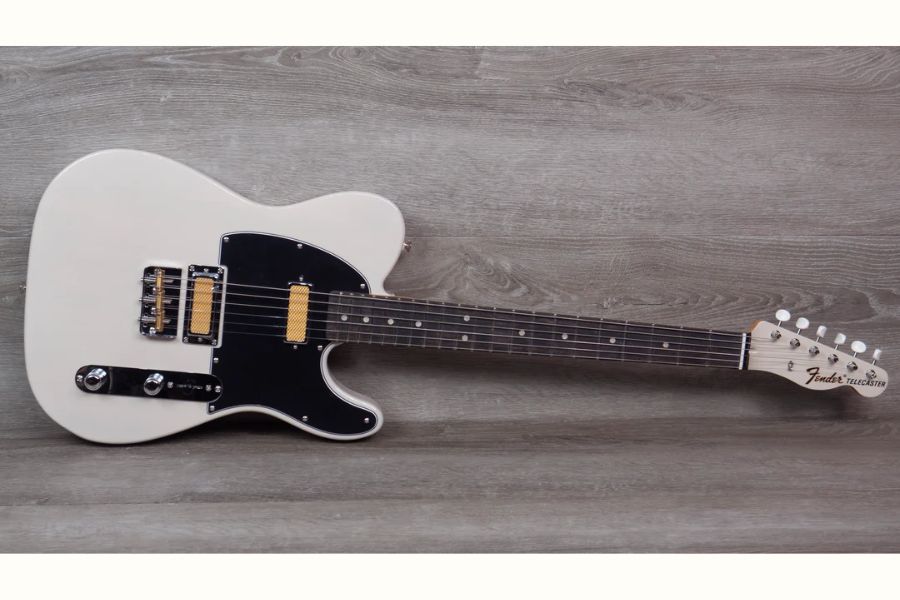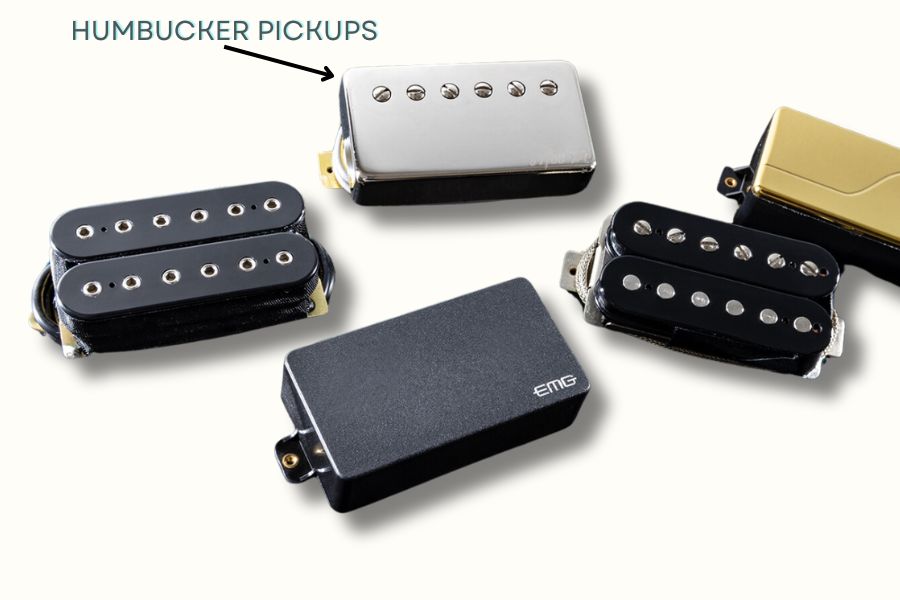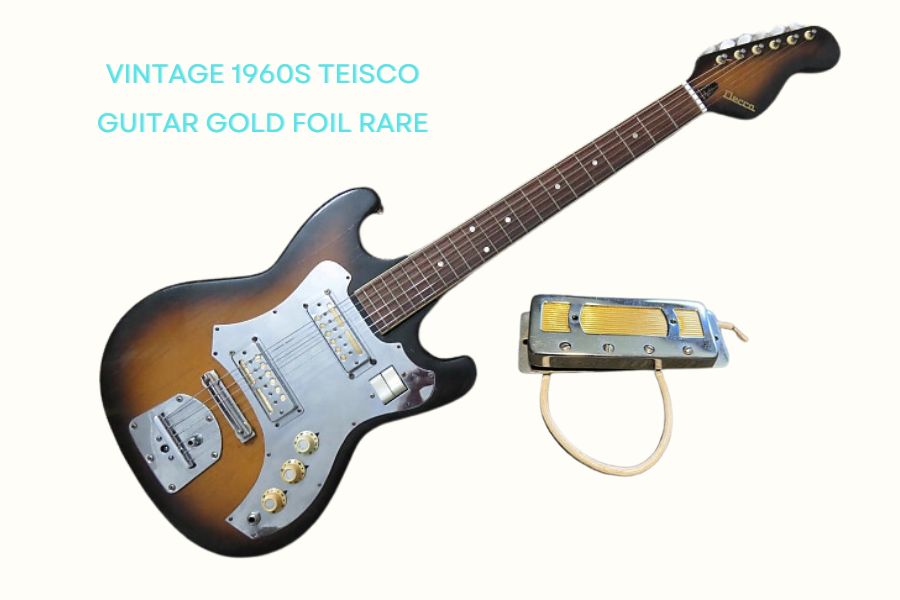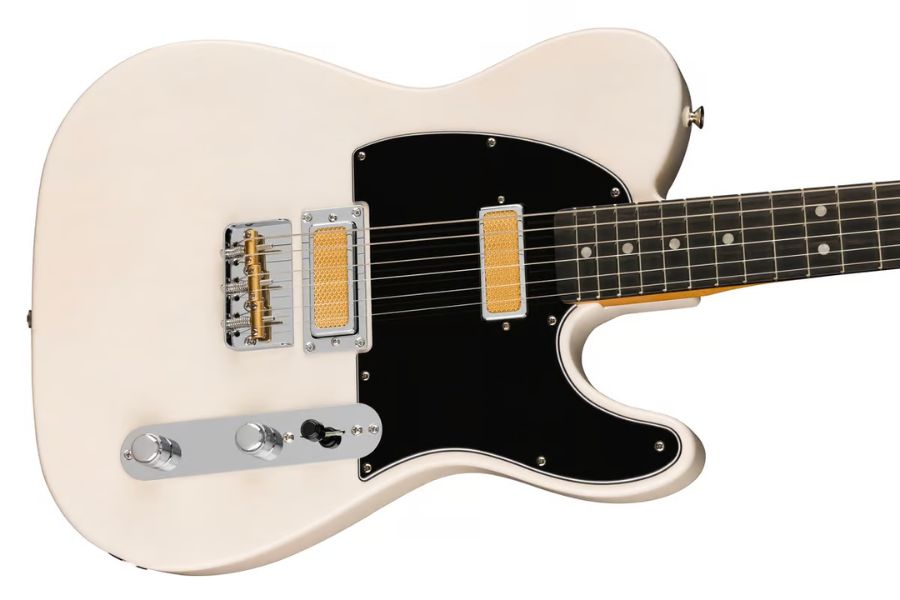A telecaster is not always a telecaster. In this case, it has a mahogany body, an ebony fingerboard, and a set of mini-humbuckers.
The name “Gold Foil” in the context of the Fender Gold Foil Telecaster is more about evoking a certain aesthetic and nostalgic appeal rather than describing the actual construction of the pickups.
Let’s explore this unique Telecaster line, examining the key details that every electric guitar enthusiast will appreciate.
Guitar Construction and Aesthetic

The Fender Gold Foil Telecaster is built in Fender’s Mexico factory, which often brings its purchase price into a more affordable range compared to its US-made counterparts.
It features a mahogany body, maple neck, and an ebony fingerboard. The fretboard has a Gibson-like 305mm (12-inch) radius and is fitted with medium jumbo frets, which are larger than those typically found on vintage models. Also, a black-painted headstock with Kluson-style tuners.
White Blonde and Candy Apple Red are the available finishes; the former stands out from the crowd because to its translucent appearance, which is a nice change from the usual opaque hues that subtly shows off the wood’s light striping.
The design includes a cut-off Tele-style bridge with uncompensated brass saddles and a chromed pickup-mounting ring that neatly houses the bridge pickup. The neck’s ergonomic design of the slim C shape makes it much easier to play.
Performance and Sound

The Fender Gold Foil Telecaster is equipped with Fender’s own mini humbucker gold foil pickups with a hum-cancelling feature. You can really hear the difference between these pickups because these pickups have unique sound, a wide dynamic range, and they are sensitive to pick attack. It makes chime and shine sounds that are very different from those made by regular Telecaster or Stratocaster pickups.
Traditional gold foil pickups, which first became popular on budget guitars from brands like Teisco and Harmony in the 1950s and 60s, used a visually distinctive gold-colored foil on their covers and typically employed rubberized ferrite magnets, which are weaker than the alnico or ceramic magnets found in most modern guitar pickups. These original gold foils are known for their unique, jangly sound which is quite distinct from the sound produced by mini-humbuckers.
Fender’s use of the “Gold Foil” name in this model likely serves to tap into the popularity and unique vintage appeal of gold foil pickups, associating the guitar with the lo-fi, retro sound that these pickups are known for, even though the actual pickups in the guitar are not true to the original gold foil design.

These are not traditional single-coil pickups but provide a unique blend of old charm and new technology. The gold foil pickups are really the primary reason to consider purchasing this model.
The tuning and intonation are rock solid, even with the uncompensated brass barrel saddle.
When attached to a clean amplifier, the guitar sounds best with both the volume and tone settings all the way open. I liked how clear and high-quality the pickups were when the onboard level and tone settings weren’t in the way.
The hardware includes vintage-style tuners with white buttons and a custom bridge that supports both string-through-body and top-load stringing options.
Shortcomings

When it comes to the performance and sound of the Fender Gold Foil Telecaster, it has drawn some serious criticism.
The guitar does not have standard gold foil pickups, despite its name. It has mini-humbuckers with alnico magnets instead of the original gold foil pickups, which were known for their unique sound made possible by rubbery ferrite magnets.
The electronics, specifically the volume and tone spots, are sometimes not working well unless you set them to their highest level. The volume control had a good fade from 10 to 8, but any lower than that and the treble was lost and the overall sound got worse.
The sound has a clear Telecaster twang and doesn’t mix with the unique tones you’d expect from real gold foil pickups.
Also, the bridge plate and saddles aren’t very good, so I suggest you upgrade them, replace the bridge plate and saddles immediately to improve intonation and sound quality.
Read more: Why does your electric guitar sound bad?
Conclusion
Even though there were some problems, mostly with the built-in electronics, I still liked the guitar’s sound and feel enough that I would suggest it if you are looking for a unique Telecaster with a chime-like sound. It sounds like a mix of Telecaster and Gibson-style mini-bucker tones and has a unique sound and shape that makes it stand out in Fender’s lineup.
Even though the guitar doesn’t sound like real gold foil, it is still praised as a beautiful and inspiring instrument. Keep in mind that you need to make some modifications to the guitar’s hardware and electronics in order to make it sound better.









